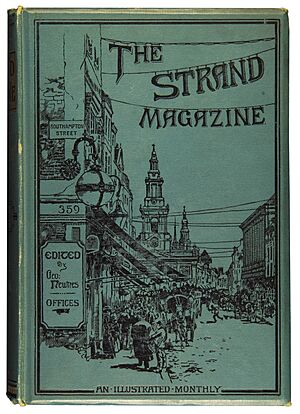George Charles Haité facts for kids
Quick facts for kids
George Charles Haité
|
|
|---|---|

Caricature of George Charles Haité by Tom Browne
|
|
| Born |
George Charles Haité
8 June 1855 Bexleyheath, England
|
| Died | 31 March 1924 (aged 68) London, England
|
| Nationality | English |
| Known for | Painting, Illustration, Textile |
George Charles Haité (born June 8, 1855 – died March 31, 1924) was a talented English artist. He was a designer, painter, illustrator, and writer. He is most famous for creating the well-known cover design of Strand Magazine. This magazine started in 1891 and helped make the Sherlock Holmes stories by Arthur Conan Doyle very popular. Haité also helped start the London Sketch Club and was its first president.
Contents
Life and Art of George Haité
George Charles Haité was born in Bexleyheath, England, on June 8, 1855. His family came from French Huguenot immigrants. He often said that "art holds no nationality," meaning art is for everyone, no matter where they come from.
His great-grandfather and grandfather worked in the calico printing business. This was a way of printing patterns on cloth. His father, George Haité, was a famous designer of cashmere shawls. However, his father did not want George to follow in his footsteps. Sadly, his father died young when George was only 16. This meant George had to become the head of his family.
Haité later wrote that he taught himself everything he knew about art. In the early 1870s, he moved to London. There, he became known for designing wallpaper and carpets. He also worked with metal, tapestries, and stained glass.
In 1883, he showed his first painting at the Royal Academy. This is a very important art institution in London. Haité painted using both oil and watercolor paints. He often painted landscapes, especially during his travels. He visited places like Venice, Morocco, and Northern Europe. In 1897, his painting of a street in Dortmund won a gold prize at the Crystal Palace exhibition. He usually signed his artwork "Geo C. Haité" or "G.C. Haité".
His friend, Frederic Villiers, said that Haité was very fast at painting. He could quickly capture a scene on his canvas. Villiers noted that Haité's memory was amazing. He could paint a Dutch market, a street in Bruges, or a suburb in Tangier very accurately, even hours after seeing them.
Haité was a very busy person. He was a member or president of many art societies. These included the Royal Institute of Painters in Watercolours and the Royal Society of British Artists. He also wrote and gave talks about art and design. In 1897, he became president of the Nicolson Institute art gallery.
Illustration Work and The Strand Magazine
In 1886, Haité published a book called Plant Studies for Artists, Designers and Art Students. This was his only book that he wrote and illustrated completely by himself. However, he also drew pictures for many other books.
In late 1890, George Newnes, the editor of a new magazine, asked Haité to design its cover. The magazine was called The Strand. It started in January 1891. The magazine became very popular when it began publishing the Sherlock Holmes stories. The first one was A Scandal in Bohemia in July 1891. Haité's cover design showed London's Strand street. The magazine's title looked like it was hanging from telegraph wires. This design became a famous symbol of publishing in the late 1800s.
Haité's design was also used for The Strand Musical Magazine. Variations of his design appeared on several first edition books of Sherlock Holmes stories.
The London Sketch Club
In 1898, Haité played a key role in starting the London Sketch Club. This club was formed by artists who left another club called the Langham Sketching Club. Haité had been president of the Langham club before. The artists left because of a small disagreement about whether to have hot or cold suppers! Artists like Tom Browne, John Hassall, and Dudley Hardy wanted hot suppers. They left to create their own drawing club. Haité was asked to be their first president. The London Sketch Club held its first dinner on April Fool's Day.
Many drawings and cartoons from the London Sketch Club show what Haité looked like. They also show his unique way of acting. He was often drawn giving a speech, waving his arms, with his hair standing up, and a big mustache. He loved to give speeches, so other members often made fun of him in a friendly way. Famous guests at the club during his time included Robert Baden-Powell and Arthur Conan Doyle. Haité and Conan Doyle both loved cricket.
After being president for four years, Haité stepped down in 1902. After that, the club elected a new president every year. Haité was still welcome at the Langham Sketching Club. He was even elected its president one last time in 1908.
Death and Legacy
In 1883, Haité married Fanny Hodgkinson. They lived in a new garden area called Bedford Park near Chiswick. They lived and worked at two different houses there, both named Ormsby Lodge. They had one daughter, Elsie Blanche Evelyn Frances Haité. George Haité was unwell for the last nine years of his life. He passed away on March 31, 1924. His wife, Fanny, stayed at Ormsby Lodge until she died in 1935.
You can see some of George Charles Haité's work, and his father's work, in the prints and drawings collection at the Victoria and Albert Museum in London.
Images for kids




